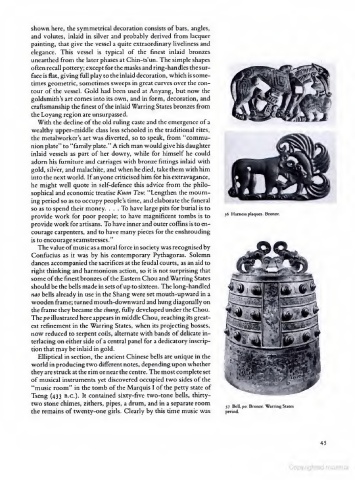Page 65 - The Arts of China, By Michael Sullivan Good Book
P. 65
shown here, the symmetrical decoration consists of bars, angles,
and volutes, inlaid in silver and probably derived from lacquer
painting, that give the vessel a quite extraordinary liveliness and
elegance. This vessel is typical of the finest inlaid bronzes
unearthed from the later phases at Chin-ts'un. The simple shapes
often recall pottery; except for the masks and ring-handles the sur-
face is flat, giving full play to the inlaid decoration, which is some-
times geometric, sometimes sweeps in great curves over the con-
tour of the vessel. Gold had been used at Anyang, but now the
goldsmith's art comes into its own, and in form, decoration, and
craftsmanship the finest of the inlaid Warring States bronzes from
the Loyang region are unsurpassed.
With the decline of the old ruling caste and the emergence of a
wealthy upper-middle class less schooled in the traditional rites,
the metalworker's art was diverted, so to speak, from "commu-
nion plate" to "family plate." A rich man would give his daughter
inlaid vessels as part of her dowry, while for himself he could
adorn his furniture and carriages with bronze fittings inlaid with
gold, silver, and malachite, and when he died, take them with him
into the next world. If anyone criticised him for his extravagance,
he might well quote in self-defence this advice from the philo-
sophical and economic treatise Kuan Tzu: "Lengthen the mourn-
ing period so as to occupy people's time, and elaborate the funeral
so as to spend their money. ... To have large pits for burial is to
56 Harness plaques. Bronze
provide work for poor people; to have magnificent tombs is to
provide work for artisans. To have inner and outer coffins is to en-
courage carpenters, and to have many pieces for the enshrouding
is to encourage seamstresses."
The value of music as a moral force in society was recognised by
Confucius as it was by his contemporary Pythagoras. Solemn
dances accompanied the sacrifices at the feudal courts, as an aid to
right thinking and harmonious action, so it is not surprising that
some of the finest bronzes of the Eastern Chou and Warring States
should be the bells made in sets of up to sixteen. The long-handled
nao bells already in use in the Shang were set mouth-upward in a
wooden frame; turned mouth-downward and hung diagonally on
the frame they became the chung, fully developed under the Chou.
The po illustrated here appears in middle Chou, reaching its great-
est refinement in the Warring States, when its projecting bosses,
now reduced to serpent coils, alternate with bands of delicate in-
terlacing on either side of a central panel for a dedicatory inscrip-
tion that may be inlaid in gold.
Elliptical in section, the ancient Chinese bells are unique in the
world in producing two different notes, depending upon whether
they are struck at the rim or near the centre. The most complete set
of musical instruments yet discovered occupied two sides of the
"music room" in the tomb of the Marquis I of the petty state of
Tseng (433 B.C.). It contained sixty-five two-tone bells, thirty-
two stone chimes, zithers, pipes, a drum, and in a separate room
57 Bcll.po. Bronze Warring States
the remains of twenty-one girls. Clearly by this time music was period
45

